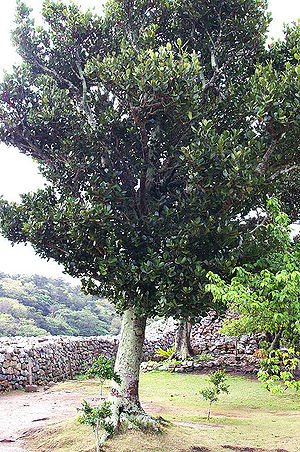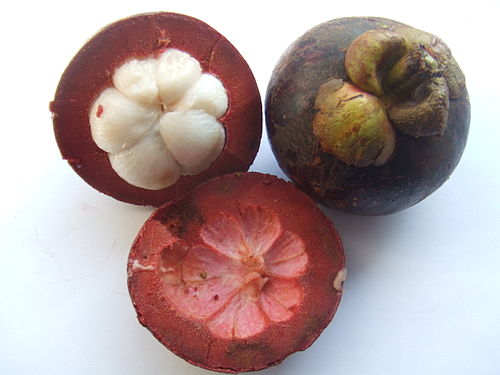Difference between revisions of "Garcinia"
| (2 intermediate revisions by 2 users not shown) | |||
| Line 1: | Line 1: | ||
| − | + | {{SPlantbox | |
| − | | | + | |genus=Garcinia |
| − | + | |Min ht metric=cm | |
| − | + | |Temp Metric=°F | |
| − | + | |image=Garcinia sessilis, flower.jpg | |
| − | + | |image_width=220 | |
| − | + | |image_caption=Heilala (Garcinia sessilis) flowers | |
| − | |||
| − | |||
| − | |||
| − | |||
| − | |||
| − | | | ||
| − | | | ||
| − | |||
| − | |||
| − | |||
| − | | image = Garcinia sessilis, flower.jpg | ||
| − | | image_width = | ||
| − | | image_caption = Heilala (Garcinia sessilis) flowers | ||
| − | |||
| − | |||
| − | |||
| − | |||
| − | |||
| − | |||
| − | |||
| − | |||
| − | |||
}} | }} | ||
| + | {{Inc| | ||
| + | Rheedia (named after H. van Rheede 1635- 1691). Guttiferae. Trees, full | ||
| + | of yellow sap, some of them with edible fruit. | ||
| + | |||
| + | Leaves rigid, leathery, lightly feather-veined: peduncles axillary or | ||
| + | lateral, the male fascicled, the female fewer: fls. often small, | ||
| + | polygamous-dioecious; sepals 2, often connate at the base; petals 4, | ||
| + | decussately imbricated; ovary 3- (rarely 4-5-) celled: berry corticose | ||
| + | and indehiscent.—-About 30 species, Trop. Amer. | ||
| + | }} | ||
| + | |||
{{Inc| | {{Inc| | ||
Garcinia (Laurence Garcin, who lived and collected in India, and wrote in the eighteenth century). Guttiferae. This genus includes the mango- steen, which is declared by some connoisseurs to be one of the most luscious of all tropical fruits; also the gamboge tree, whose resinous juice yields a well-known pigment and purgative. | Garcinia (Laurence Garcin, who lived and collected in India, and wrote in the eighteenth century). Guttiferae. This genus includes the mango- steen, which is declared by some connoisseurs to be one of the most luscious of all tropical fruits; also the gamboge tree, whose resinous juice yields a well-known pigment and purgative. | ||
| − | Garcinia is a polymorphous genus of upward of 150 species in the tropics of Asia, Africa and Polynesia. The species are glabrous trees, usually with a yellow juice: lvs. evergreen, opposite or ternate, simple, often thick: fls. solitary or fascicled, polygamous or dioecious; sepals and petals 4; stamens in male fl. many, 2- or 3-delphousj female fls. with staminodia; ovary 2- to many-celled, with sessile stigma and solitary ovule in each cell.—The mangosteen is cultivated in the West Indies; the gamboge tree is also cult, in S. Fla.; it is a broad- leaved tree of slow growth. The mangosteen is about the siz€ and shape of an orange, with a rind of similar thickness and edible segments of form and arrangement like those of an orange. It is brilliantly colored outside with rich purple. The flavor is said to suggest something between a grape and a peach. Numberless efforts are said to have been made to naturalize this tree in the tropics without success. The successful ripening of this fruit under glass may be regarded as an achievement. See Mangosteen. | + | Garcinia is a polymorphous genus of upward of 150 species in the tropics of Asia, Africa and Polynesia. The species are glabrous trees, usually with a yellow juice: lvs. evergreen, opposite or ternate, simple, often thick: fls. solitary or fascicled, polygamous or dioecious; sepals and petals 4; stamens in male fl. many, 2- or 3-delphousj female fls. with staminodia; ovary 2- to many-celled, with sessile stigma and solitary ovule in each cell.—The mangosteen is cultivated in the West Indies; the gamboge tree is also cult, in S. Fla.; it is a broad- leaved tree of slow growth. The mangosteen is about the siz€ and shape of an orange, with a rind of similar thickness and edible segments of form and arrangement like those of an orange. It is brilliantly colored outside with rich purple. The flavor is said to suggest something between a grape and a peach. Numberless efforts are said to have been made to naturalize this tree in the tropics without success. The successful ripening of this fruit under glass may be regarded as an achievement. See [[Mangosteen]]. |
{{SCH}} | {{SCH}} | ||
| Line 45: | Line 34: | ||
===Pests and diseases=== | ===Pests and diseases=== | ||
{{edit-pests}}<!--- Type pest/disease info below this line, then delete this entire line --> | {{edit-pests}}<!--- Type pest/disease info below this line, then delete this entire line --> | ||
| + | Canker on stems, young and older branches (Zignoella garcineae) | ||
| + | -Thread blight (Pellicularia koleroga cooke) | ||
| + | - Post harvest decay (Botryodiplodia theobromae) | ||
==Species== | ==Species== | ||
| Line 154: | Line 146: | ||
{{stub}} | {{stub}} | ||
| − | + | __NOTOC__ | |
| − | |||
| − | |||
Latest revision as of 06:46, 8 June 2010
|
Garcinia > |
Read about Garcinia in the Standard Cyclopedia of Horticulture
|
|---|
|
Rheedia (named after H. van Rheede 1635- 1691). Guttiferae. Trees, full of yellow sap, some of them with edible fruit. Leaves rigid, leathery, lightly feather-veined: peduncles axillary or lateral, the male fascicled, the female fewer: fls. often small, polygamous-dioecious; sepals 2, often connate at the base; petals 4, decussately imbricated; ovary 3- (rarely 4-5-) celled: berry corticose and indehiscent.—-About 30 species, Trop. Amer.
|
Read about Garcinia in the Standard Cyclopedia of Horticulture
|
|---|
|
Garcinia (Laurence Garcin, who lived and collected in India, and wrote in the eighteenth century). Guttiferae. This genus includes the mango- steen, which is declared by some connoisseurs to be one of the most luscious of all tropical fruits; also the gamboge tree, whose resinous juice yields a well-known pigment and purgative. Garcinia is a polymorphous genus of upward of 150 species in the tropics of Asia, Africa and Polynesia. The species are glabrous trees, usually with a yellow juice: lvs. evergreen, opposite or ternate, simple, often thick: fls. solitary or fascicled, polygamous or dioecious; sepals and petals 4; stamens in male fl. many, 2- or 3-delphousj female fls. with staminodia; ovary 2- to many-celled, with sessile stigma and solitary ovule in each cell.—The mangosteen is cultivated in the West Indies; the gamboge tree is also cult, in S. Fla.; it is a broad- leaved tree of slow growth. The mangosteen is about the siz€ and shape of an orange, with a rind of similar thickness and edible segments of form and arrangement like those of an orange. It is brilliantly colored outside with rich purple. The flavor is said to suggest something between a grape and a peach. Numberless efforts are said to have been made to naturalize this tree in the tropics without success. The successful ripening of this fruit under glass may be regarded as an achievement. See Mangosteen.
|
Cultivation
- Do you have cultivation info on this plant? Edit this section!
Propagation
- Do you have propagation info on this plant? Edit this section!
Pests and diseases
- Do you have pest and disease info on this plant? Edit this section!
Canker on stems, young and older branches (Zignoella garcineae) -Thread blight (Pellicularia koleroga cooke) - Post harvest decay (Botryodiplodia theobromae)
Species
Selected specieswp:
Gallery
If you have a photo of this plant, please upload it! Plus, there may be other photos available for you to add.
Whole (top right) and opened fruits of the Purple Mangosteen (Garcinia mangostana); note the white edible arils
References
- Standard Cyclopedia of Horticulture, by L. H. Bailey, MacMillan Co., 1963
External links
- w:Garcinia. Some of the material on this page may be from Wikipedia, under the Creative Commons license.
- Garcinia QR Code (Size 50, 100, 200, 500)





